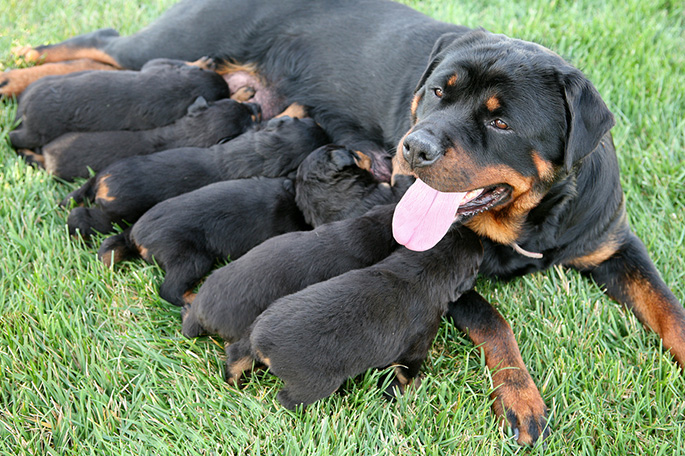What to Expect When Your Pet is Expecting

Many people see their pet as their own child, but what do you do when you find that your little one will soon be having children of their own? Knowing how to care for your pet during pregnancy and after childbirth is essential for any responsible pet owner.
So how do you tell if your pet is expecting? “Some telltale signs to watch for in a pregnant pet are lethargy, not wanting to eat as much, not playing as much as usual and enlarged nipples,” said Jean Laird, veterinary technician at the Texas A&M College of Veterinary Medicine & Biomedical Sciences (CVM). “These are attributed to a change in hormones and milk production. Even if you are sure there is no way a dog has gotten in your yard, it is best to take her to the veterinarian to confirm if she is pregnant. Intact male dogs are surprisingly persistent when a female is in heat. While there is a pregnancy test for pets, a small litter may result in a false negative.”
If you believe your pet is pregnant, the first thing you should do is take her in to see a veterinarian. Certain conditions exist that may appear to be pregnancy, but in reality are alarming and may even be life threatening.
“One condition that can be deadly is called pyometra,” said Laird. “It is a bacterial infection that occurs during their heat cycle and results in the uterus filling with pus. This is a serious condition that requires immediate surgery and hospitalization. Symptoms include fever, lethargy, and vaginal discharge that is commonly confused with standard pregnancy discharge.”
When preparing your home for a pregnant pet, there are several conditions that must be met to guarantee that your pet is safe and comfortable throughout their pregnancy.
“First your dog will need a whelping bed,” said Laird. “This can be a kiddie pool or blocked off area with blankets as long as it is a secure area, provides easily accessible food and water to the mother, and is protected from the elements. The mother will need to be fed high quality puppy food until her little ones are weaned. Though puppies are not born with their eyes open, they move around a great deal so it is important to encourage the mother to stay with the puppies. Be extremely cautious about heating pads, and if you decide to use one keep them on low at all times. Many puppies are injured and even killed because they do not have the ability to get off of a hot heating pad.”
After your pet has given birth it is important that both the mother and newborn puppies be examined by your veterinarian as soon as possible. The vet will be able to ensure the physical condition of the mother and her puppies, as well as make recommendations to provide the best care. Your vet can also set up an appropriate schedule for your new puppies to be dewormed and vaccinated.
“After your pet has given birth, keep her confined with the puppies as much as possible and carefully observe her to see if she is gentle with the puppies and allows them to nurse,” said Laird. “If she lays on them, tries to injure them, or does not allow them to nurse, you will have to bottle feed the puppies. There is powder milk available through your veterinarian and feed stores that is specifically made for puppies. Avoid giving them cow’s milk, as this is not adequate nutrition for the growth and development of a puppy.”
Pet Talk is a service of the College of Veterinary Medicine & Biomedical Sciences, Texas A&M University. Stories can be viewed on the Web at vetmed.tamu.edu/news/pet-talk. Suggestions for future topics may be directed to editor@cvm.tamu.edu.


